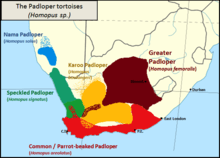Homopus
| Homopus | |
|---|---|
 | |
| Common padloper (Homopus areolatus) | |
| Scientific classification | |
| Kingdom: | Animalia |
| Phylum: | Chordata |
| Class: | Reptilia |
| Order: | Testudines |
| Suborder: | Cryptodira |
| Family: | Testudinidae |
| Genus: | Homopus A.M.C. Duméril & Bibron, 1834[1] |
| Species | |
|
At least five recognized species | |
Homopus is a genus of tiny tortoises in the family Testudinidae, endemic to southern Africa. The genus includes the smallest tortoises in the world.
Naming
As a group, these closely related species are commonly known in Europe and Africa as padlopers (originally meaning "path-walkers" in Afrikaans), due to their habit of making tiny pathways through vegetation.[2][3] In other parts of the world, such as the United States, they are known as Cape tortoises, as three of the five species live relatively near to the Cape of Good Hope.[1][4]
Distribution
The genus is indigenous and endemic to southern Africa, with three of the species occurring only within South Africa, one only in Namibia, and one possibly spanning across the border region of both countries.

Species
The genus contains these species:
- H. areolatus (common padloper or parrot-beaked tortoise), of the southern Cape coastal region, the most common padloper species.[5]
- H. boulengeri (Karoo padloper or Boulenger's cape tortoise), of the Karoo region[6]
- H. femoralis (greater padloper or Karoo cape tortoise [sic]), of the highveld grasslands, the largest of the padlopers[6]
- H. signatus (speckled padloper or speckled tortoise), of the South African west coast region, the smallest tortoise species in the world
- H. solus (Nama padloper or Berger's cape tortoise, previously H. bergeri), of southern Namibia[7]
Conservation and captivity
They are threatened by habitat destruction,[4] traffic on roads, overgrazing, and poaching for the pet trade.[6] Another threat comes from introduced species, such as domestic dogs and pigs.
Among the Homopus species, H. areolatus and H. signatus adapt well to captivity, as their diets are not highly specialized.[3] The others do not generally survive well in captivity unless some effort is made to supply them with their natural food, that is, endemic plants from the Cape/Karoo regions.[3] Many are taken from their natural habitat each year, and subsequently die as a result, as they do not readily adapt to typical captive diets and environment change.[3] However, they can be very hardy in captivity, and most problems with captive care are caused by faulty nutrition, high humidity, or bad husbandry.[3]
References
| Wikimedia Commons has media related to Homopus. |
- 1 2 ITIS (Integrated Taxonomic Information System). www.itis.gov.
- ↑ "Homopus Research Foundation, reports". Home.caiway.nl. Retrieved 2017-07-17.
- 1 2 3 4 5 Corton, M., Homopus (Padloper Tortoise) Care, World Chelonian Trust (retrieved August 20, 2013).
- 1 2 Obst, J.; Richter, K.; Jacob, U. (1988). The Completely Illustrated Atlas of Reptiles and Amphibians for the Terrarium. T.F.H. press.
- ↑ "Scarce Home". Academic.sun.ac.za. Retrieved 2017-07-17.
- 1 2 3 "Homopus Research Foundation". Home.caiway.nl. Retrieved 2017-07-17.
- ↑ "Nama Padloper Tortoise | Namibia". Namibian.org. Retrieved 2017-07-17.
